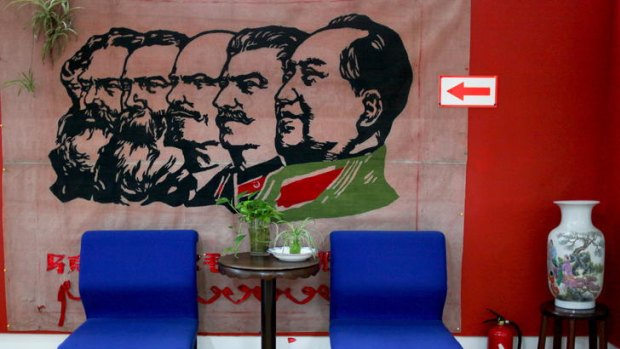
Political pin-ups ... inside the museum.Credit: Alamy
It's only small, but this art collection packs a punch, writes Steve McKenna.
THE forest of nondescript residential high-rises looks almost out of place in Shanghai's charming former French Concession neighbourhood. Hidden somewhere within, however, is one man's ode to the arty propaganda that fuelled Mao-era China. I just have to find it.
My target, and my confusion, must be obvious because, without a word exchanged between us, the guard at the complex's security barrier disappears into a little hutch and re-emerges with a business card-cum-map marked with the words Shanghai Propaganda Poster Art Centre.
I eventually locate the right building, where I get into an elevator and plummet to a basement that's eerily quiet save for the hum of a generator.
A door leads into the art centre, the pride and joy of Yang Pei Ming, an artist who has gathered more than 5000 posters produced by China's Communist Party between 1949 and 1979. It's a collection, he says, no one else in the world can match.
The exhibition space is small – what you'd expect, perhaps, from a basement apartment. Indeed, it takes only a little more than an hour to peruse the exhibits in the handful of rooms. But what a gripping hour it is.
In the turbulent period of Maoism, a time of famine, hardship and threat of war from "evil enemies", not to mention the devastating Cultural Revolution, the posters were a way of "informing the collective mind of the Chinese people".
Yang stresses that, in the days before Fox News and CNN, "a picture was worth a thousand words" – a fact exploited to the full by Chairman Mao and his cohorts, who employed the state's most talented artists to convey the latest party line.
"Defending world peace and defeating US imperialism" is a message that courses throughout, with anti-Americanism infusing the posters. Some contain fairly gruesome images of Yankee invaders being driven into the sea, laden with greenbacks and stars-and-stripes flags – and occasionally shorn of limbs.
There are posters in support of Vietnam, Cuba and the various African and Latin American countries targeted by the US in its fight against communism, though after Richard Nixon's visit to China in 1972 – which coincided with an era of frosty Sino-Soviet relations – the vehement anti-Washington rhetoric is noticeably toned down.
Away from foreign policy, colourful posters drum up support for domestic issues; heightening industrial and agricultural production – notably the ultimately disastrous Great Leap Forward – stressing the importance of education, family, science and technology (including an ambition to enter the space race), while coming down hard on bookish, intellectual, subversive types.
In most posters, Mao is depicted like a kindly uncle, usually encircled by a giant sun.
There are also numerous images of tractor-riding peasants and cadres clutching copies of Mao's Little Red Book.
The poster production line gradually shuddered to a halt after Mao's death in 1976, especially when his eventual successor Deng Xiaoping, regarded as the father of modern China, adopted a more pro-Western political and economic stance.
It's difficult to reconcile the China of Mao with the China of today – especially when strolling around a city as modern and (relatively) open as Shanghai, where McDonald's and Starbucks seem to be sprouting on every other corner.
But, according to Yang, this makes his museum even more vital. "Today China's economic shift is well defined," he says.
"But with the shift toward a more modern and forward-thinking China, it would be a mistake to forget our recent history."
The Shanghai Propaganda Poster Art Centre, 868 Hua Shan Road, near Zhenning Lu – a 10-minute walk from Changshu Lu metro station. Open 10am-5pm daily,entrance: 20 yuan ($3), www.shanghaipropagandaart.com.
Sign up for the Traveller Deals newsletter
Get exclusive travel deals delivered straight to your inbox. Sign up now.